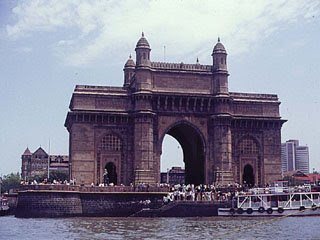Each island had not more than few hundred fishermen families.
After the arrival of European traders in India, Mumbai went under the control of Portuguese.
Soon when a Portuguese princess was married to a British prince, Mumbai was passed on to British as Dowry.
Every ruler who ruled India has given India immortal monuments.
Mumbai is gifted with many of such monuments.
Gateway of India for Instance.

Mumbai's most famous monument, this is the starting point for most tourists who want to explore the city. It was built as a triumphal arch to commemorate the visit of King George V and Queen Mary, complete with four turrets and intricate latticework carved into the yellow basalt stone. Ironically, when the Raj ended in 1947, this colonial symbol also became a sort of epitaph: the last of the British ships that set sail for England left from the Gateway. Today this symbol of colonialism has got Indianised, drawing droves of local tourists and citizens. Behind the arch, there are steps leading down to the water. Here, you can get onto one of the bobbing little motor launches, for a short cruise through Mumbai's splendid natural harbour.
Chattrapati Shivaji Terminus

The station was designed by Frederick William Stevens, a consulting architect in 1887-1888. He received as payment 16.14 lakh rupees. Stevens earned the commission to construct the station after a masterpiece watercolour sketch by draughtsman Axel Haig. The final design bears some resemblance to St Pancras station in London.
It took ten years to complete and was named "Victoria Terminus" in honour of the Queen and Empress Victoria; it was opened on the date of her Golden Jubilee in 1887. This famous architectural landmark in Gothic style was built as the headquarters of the great Indian Peninsular Railway. Since then the station came to be known as Bombay VT.
In 1996, in response to demands by the Shiv Sena and in keeping with the policy of renaming locations with Indian names, the station was renamed by the state government after Chatrapati Shivaji, a famed 17th century Maratha king. On 2 July 2004 the station was nominated a World Heritage Site by the World Heritage Committee of UNESCO.
Crawford Market

Crawford Market (officially Mahatma Jyotirao Phule Market) is one of South Mumbai's most famous markets. It is named after Arthur Crawford, the first Municipal Commissioner of the city. The market is situated opposite the Mumbai Police headquarters, just north of Victoria Terminus railway station and west of the J.J.flyover at a busy intersection. The market houses a wholesale fruit, vegetable and poultry market. One end of the market is a pet store. Most of the sellers inside the market nowadays sell imported items such as foods, cosmetics, household and gift items. It was the main wholesale market for fruits in Mumbai until March 1996, when the wholesale traders were relocated to Navi Mumbai (New Bombay).
The building, completed in 1869, was donated to the city by Cowasji Jehangir. After India's independence, the market was renamed after Maharashtrian social reformer, Mahatma Jyotirao Phule. In 1882, the building was the first in India to be lit up by electricity.
The edifice is a blend of Norman and Gothic architectural styles. The friezes on the outside entrance depicting Indian farmers, and the stone fountains inside, were designed by Lockwood Kipling, father of novelist Rudyard Kipling. The market covers an area of 22,471 sq m (24,000 sq ft) which 5,515 sq m (6,000 sq ft) is occupied by the building itself. The structure was built using coarse buff coloured Kurla stone, with redstone from Bassein. It has a 15 m high skylight awning designed to allow the sunlight light up the marketplace.
High Court of Mumbai

On the fringes of what was once the walled Fort of Mumbai, stands the High Court, another hauntingly beautiful (some say haunted!) structure, in brooding black stone. Opposite it lies the Oval Maidan, formerly a large Bowling Green where English memsahibs came to "take in the air." Today, it is an important lung in a congested city, where aspiring young cricketers practice their paces under the watchful eye of the High Court and the Mumbai University.
Flora Fountain

Flora Fountain is a stone fountain situated in Fort business district in the heart of South Mumbai, Mumbai, India. Flora Fountain was built in 1864. The fountain depicts the Roman goddess Flora. It is now a heritage structure. It was built at a total cost of Rs. 47,000, or 9000 pounds sterling, a princely sum in those days.




No comments:
Post a Comment